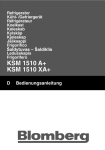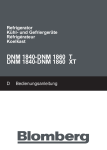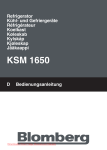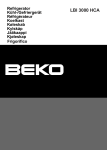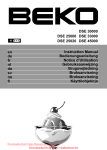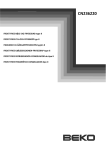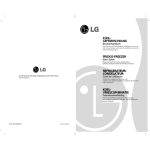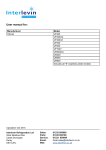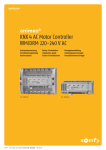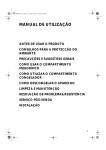Download Blomberg KSM 1510 Instruction manual
Transcript
Refrigerator Kühl- /Gefriergerät Réfrigérateur Koelkast Køleskab Kylskåp Kjøleskap Jääkaappi KSM 1510 A+ KSM 1510 XA+ D Bedienungsanleitung GB Index 1-9 Safety first/1 Electrical requirements/2 Transportation instructions/2 Installation instructions/2 Getting to know your appliance/3 Suggested arrangement of food in the appliance/3 Temperature control and adjustment/4 Before operating/4 Storing frozen food/5 Freezing fresh food/5 Making ice cubes/5 Defrosting/6 Replacing the interior light bulb/6 Cleaning and care/6-7 Do’s and don’ts/7-8 Trouble - shooting/8 Repositioning the doors/9 D Inhalt 10-19 Wichtige Sicherheitshinweise/10 Elektrische Voraussetzungen/11 Transporthinweise/11 Aufstellen des Gerätes/11 Lernen Sie Ihr neues Gerät kennen/12 Empfohlene Lagerung der Lebensmittel in Ihrem Gerät/12 Temperaturkontrolle und -einstellung/13 Vor der Inbetriebnahme/13 Lagerung von Tiefkühlkost/14 Tiefkühlen frischer Lebensmittel/14 Herstellung von Eiswürfeln/14 Abtauen/15 Austausch der Glühlampe der Innenbeleuchtung/15 Reinigung und Pflege/15 Wichtige Hinweise – Bitte beachten/16 Fehlerbeseitigung/17 Änderung der Türanschläge/18 Garantiebedingungen/19 F Sommaire 20-28 Priorité à la sécurité/20 Exigences électriques/21 Instructions pour le transport/21 Instructions pour l’installation/21 A la découverte de l’appareil/22 Suggestion de rangement des aliments dans l’appareil/22 Contrôle et réglage de la température/23 Avant la mise en marche/23 Conservation des aliments surgelés/24 Congélation d’aliments frais/24 Fabrication de glaçons/24 Dégivrage/25 Remplacement de l’ampoule de l’éclairage intérieur/25 A faire et à ne pas faire/26 Dépannage/27 Réversibilité des portes/28 NL Inhoud 29-37 Veiligheid voor alles/29 Elektrische vereisten/30 Vervoerinstructies/30 Instructies voor de installatie/30 Het apparaat leren kennen/31 Aanbevolen rangschikking van levensmiddelen in het apparaat/31 Temperatuur regelen en instellen/32 Voordat u het apparaat in gebruik neemt/32 Bewaren van bevroren levensmiddelen/33 Invriezen van verse levensmiddelen/33 IJsblokjes maken/33 Ontdooien/34 Het lampje van de binnenverlichting vervangen/34 Schoonmaken en onderhoud/34 Wat wel en wat niet mag/35 Problemen oplossen/36 De deuren omdraaien/37 DK Inhold 38-47 Sikkerhed frem for alt /38 Krav til elektricitet /39 Instruktioner vedr. fragt /39 Vejledning vedr. installation /39 Bliv fortrolig med Deres køle-fryseskab /40 Forslag til placering af madvarer i køle-fryseskabet /40 Temperaturstyring og justering /41 Før ibrugtagning /41 Opbevaring af frosne madvarer /42 Indfrysning af friske madvarer /42 Fremstilling af isterninger /42 Afisning /43 Udskiftning af den indvendige el-pære /43 Rengøring og vedligeholdelse /43 Vigtigt at huske og at undgå /44 Fejlfinding/45 Åbning af dør til modsat side/46 Kære kunde/47 S Register 48-57 Säkerheten först/48 Elektriska krav/49 Transportinstruktioner/49 Installationsinstruktioner/49 Lär känna din enhet/50 Förslag på placering av maten i enheten/50 Temperaturkontroll och justering/51 Innan du använder enheten/51 Förvaring av fryst mat/52 Infrysning av färsk mat/52 Göra isbitar/52 Avfrostning/53 Byte av innerbelysningens glödlampa/53 Rengöring och vård/53 Viktiga saker att göra och inte göra/54 Felsökning/55 Omhängning av dörrarna/56 Bästa kund/57 N Indeks 58-67 Sikkerhet først /58 Krav til det elektriske anlegget /59 Transportanvisninger /59 Installasjonsanvisninger /59 Bli kjent med apparatet /60 Forslag til plassering av matvarer i apparatet/60 Temperaturkontroll og justering/61 Før bruk/61 Oppbevaring av frosne matvarer/62 Frysing av ferske matvarer/62 Lage isbiter/62 Avising/63 Utskifting av innvendig lyspære/63 Rengjøring og stell/63 Ting du må gjøre og ting du ikke må gjøre/64 Feilretting/65 Omhengsling av dører/66 Kjære kunde/67 SF Sisällysluettelo 68-76 Turvallisuus ensin/68 Sähkötekniset vaatimukset /69 Kuljetusohjeet /69 Asennusohjeet /69 Laitteen ominaisuudet/70 Ehdotus ruokien sijoittamisesta laitteeseen /70 Lämpötilan ohjaus ja säätö /71 Ennen käyttöä /71 Pakastetun ruuan säilyttäminen /72 Tuoreen ruuan pakastaminen /72 Jääpalojen teko /72 Sulatus/73 Sisälampun vaihaminen /73 Puhdistus ja huolto/73 Tee ja älä tee/74 Vianetsintä /75 Ovien asennon vaihtaminen /76 12 1 2 3 14 4 13 18 3 3 5 6 15 16 7 17 8 9 19 10 11 1 2 3 5 4 6 10 4 5 4 2 7 1 11 6 12 13 45 ° 3 9 8 18 17 16 180° 18 21 23 22 20 23 19 15 14 7 48 1014 00 02 GB Instruction Manual Congratulations on your choice of a Quality Appliance, designed to give you many years of service. Safety first! Do not connect your appliance to the electricity supply until all packing and transit protectors have been removed. • Leave to stand for at least 4 hours before switching on, to allow compressor oil to settle, if transported horizontally. • If you are discarding an old appliance with a lock or latch fitted to the door, ensure that it is left in a safe condition to prevent the entrapment of children. • This appliance must only be used for its intended purpose i.e the storing and freezing of edible foodstuff. • Do not dispose of the appliance on a fire. Your appliance contains non CFC substances in the insulation which are flammable. We suggest you contact your local authority for information on disposal and available facilities. • We do not recommend use of this appliance in an unheated, cold room. (e.g. garage, conservatory, annex, shed, out-house etc.) To obtain the best possible performance and trouble free operation from your appliance it is very important to read these instructions carefully. Failure to observe these instructions may invalidate your right to free service during the guarantee period. Please keep these instructions in a safe place for easy reference. 1 GB Instruction Manual Electrical requirements appliance, unless they are of the type recommended by the manufacturer. Before inserting the plug into the wall socket make sure that the voltage and the frequency shown in the rating plate inside the appliance corresponds to your electricity supply. We recommend that this appliance be connected to the mains supply via a suitably switched and fused socket in a readily accessible position. Warning! This appliance must be earthed. Repairs to electrical equipment should only be performed by a qualified technician. Incorrect repairs carried out by an unqualified person carry risks that may have critical consequences for the user of the appliance. • Do not dispose of the appliance on a fire. At , the care and protection of our environment is an ongoing commitment. This appliance which is among the latest range introduced is particularly environment friendly. Your appliance contains non CFC/HFC natural substances in the cooling system (called R600a) and the insulation (called cyclopentane) which are potentially flammable if exposed to fire. Therefore, take care not to damage, the cooling circuit/ pipes of the appliance in transportation and in use. In case of a damage do not expose the appliance to fire, potential ignition source and immediately ventilate the room where the appliance is situated. Transportation instructions 1. The appliance should be transported only in upright position. The packing as supplied must be intact during transportation. 2. If during the course of transport the appliance, has been positioned horizontally, it must not be operated for at least 4 hours, to allow the system to settle. 3. Failure to comply with the above instructions could result in damage to the appliance, for which the manufacturer will not be liable for. 4. The appliance must be protected against rain, moisture and other atmospheric influences. Important! • Care must be taken while cleaning/carrying the appliance not to touch the bottom of the condenser metal wires at the back of the appliance, as this could cause injury to fingers and hands. • Do not attempt to sit or stand on top of your appliance as it is not designed for such use. You could injure yourself or damage the appliance. • Make sure that the mains cable is not caught under the appliance during and after moving, as this could damage the cable. • Do not allow children to play with the appliance or tamper with the controls. • We suggest you contact your local authority for disposal information and facilities available. WARNING- Keep ventilation openings, in the appliance enclosure or in the built-in structure, clear of obstruction. Installation instructions 1. Do not keep your appliance in a room where the temperature is likely to fall below 10 degrees C (50 degrees F) at night and/or especially in winter, as it is designed to operate in ambient temperatures between +10 and +32 degrees C (50 and 90 degrees F). At lower temperatures the appliance may not operate, resulting in a reduction in the storage life of the food. 2. Do not place the appliance near cookers or radiators or in direct sunlight, as this will WARNING- Do not use mechanical devices or other means to accelerate the defrosting process, other than those recommended by the manufacturer. WARNING- Do not damage the refrigerant circuit. WARNING- Do not use electrical appliances inside the food storage compartments of the 2 GB Instruction Manual Suggested arrangement of food in the appliance cause extra strain on the appliance's functions. If installed next to a source of heat or freezer, maintain the following minimum side clearances: From Cookers 30 mm From Radiators 300 mm From Freezers 25 mm 3. Make sure that sufficient room is provided around the appliance to ensure free air circulation. • Put the back airing lid to the back of your refrigerator to set the distance between the refrigerator and the wall. 4. The appliance should be positioned on a smooth surface. The two front feet can be adjusted as required. To ensure that your appliance is standing upright adjust the two front feet by turning clockwise or anti-clockwise, until firm contact is secured with the floor. Correct adjustment of feet prevents excessive vibration and noise. 5. Refer to "Cleaning and Care" section to prepare your appliance for use. Guidelines for obtaining optimum storage and hygiene: 1. The fridge compartment is for the short-term storage of fresh food and drinks. 2. The freezer compartment is rated and suitable for the freezing and storage of pre-frozen food. The recommendation for storage as stated on the food packaging should be observed at all times. 3. Dairy products should be stored in the special compartment provided in the door liner. 4. Cooked dishes should be stored in airtight containers. 5. Fresh wrapped products can be kept on the shelf. Fresh fruit and vegetables should be cleaned and stored in the crisper bins. 6. Bottles can be kept in the door section. 7. To store raw meat, wrap in polythene bags and place on the lowest shelf. Do not allow to come into contact with cooked food, to avoid contamination. For safety, only store raw meat for two to three days. 8. Do not keep vegetable oil on door shelves. Keep the food packed, wrapped or covered. Allow hot food and beverages to cool before refrigerating. Leftover canned food should not be stored in the can. 9. Fizzy drinks should not be frozen and products such as flavoured water ices should not be consumed too cold. 10. Some fruit and vegetables suffer damage if kept at temperatures near 0 °C. Therefore wrap pineapples, melons, cucumbers, tomatoes and similar produce in polythene bags. 11. High-proof alcohol must be stored upright in tightly closed containers. Never store products that contain an inflammable propellant gas (e.g. cream dispensers, spray cans, etc.) or explosive substances. These are an explosion hazard. Getting to know your appliance (Fig. 1) 1. Thermostat knob 2. Lamp housing 3. Movable shelves 4. Wine rack 5. Defrost water collection channel Drain tube 6. Crisper cover 7. Crisper 8. Ice bank 9. Fast freeze compartment 10. Freezer compartment 11. Adjustable front feet 12. Dairy compartment 13. Adjustable door shelves 14. Egg compartment 15. Wire frame 16. Bottle holder 17. Bottle shelve 18. Fridge compartment 19. Freezer compartment 3 GB Instruction Manual Temperature control and adjustment Before operating Final Check Before you start using the appliance check that: 1. The feet have been adjusted for perfect levelling. 2. The interior is dry and air can circulate freely at the rear. 3. The interior is clean as recommended under "Cleaning and care.” 4. The plug has been inserted into the wall socket and the electricity is switched on. When the door is open the interior light will come on. Operating temperatures are controlled by the thermostat knob (Fig. 2) and may be set at any position between 1 and 5 (the coldest position). The average temperature inside the fridge should be around +5 °C (+41 °F). Therefore adjust the thermostat to obtain the desired temperature. Some sections of the fridge may be cooler or warmer (such as salad crisper and top part of the cabinet) which is quite normal. We recommend that you check the temperature periodically with a thermometer to ensure that the cabinet is kept to this temperature. Frequent door openings cause internal temperatures to rise, so it is advisable to close the door as soon as possible after use. And note that: 5. You will hear a noise as the compressor starts up. The liquid and gases sealed within the refrigeration system may also make some (noise), whether the compressor is running or not. This is quite normal. 6. Slight undulation of the top of the cabinet is quite normal due to the manufacturing process used; it is not a defect. 7. We recommend setting the thermostat knob midway and monitor the temperature to ensure the appliance maintains desired storage temperatures (See section Temperature Control and Adjustment). 8. Do not load the appliance immediately it is switched on. Wait until the correct storage temperature has been reached. We recommend checking the temperature with an accurate thermometer (see; Temperature Control and Adjustment). 4 GB Instruction Manual Storing frozen food Making ice cubes Your freezer is suitable for the long-term storage of commercially frozen foods and also can be used to freeze and store fresh food. If there is a power failure, do not open the door. Frozen food should not be affected if the failure lasts for less than 16 hrs. If the failure is longer, then the food should be checked and either eaten immediately or cooked and then re-frozen Fill the ice - cube tray 3/4 full with water and place it in the freezer. Loosen frozen trays with a spoon handle or a similar implement; never use sharp-edged objects such as knives or forks. Freezing fresh food Please observe the following instructions to obtain the best results. Do not freeze too large a quantity at any one time. The quality of the food is best preserved when it is frozen right through to the core as quickly as possible. Do not exceed the freezing capacity of your appliance in 24 h. Placing warm food into the freezer compartment causes the refrigeration machine to operate continuously until the food is frozen solid. This can temporarily lead to excessive cooling of the refrigeration compartment. When freezing fresh food, keep the thermostat knob at medium position. Small quantities of food up to 1/2 kg. (1 lb) can be frozen without adjusting the temperature control knob. Take special care not to mix already frozen food and fresh food. 5 GB Instruction Manual Defrosting on the electricity supply. A) Fridge compartment The fridge compartment defrosts automatically. The defrost water runs to the drain tube via a collection container at the back of the appliance (Fig. 4). During defrosting, water droplets may form at the back of the fridge compartment where a concealed evaporator is located. Some droplets may remain on the liner and refreeze when defrosting is completed. Do not use pointed or sharp-edged objects such as knives or forks to remove the droplets which have refrozen. If, at any time, the defrost water does not drain from the collection channel, check that no food particles have blocked the drain tube. The drain tube can be cleared with a pipe-cleaner or similar implement. Replacing the interior light bulb B) Freezer compartment Defrosting is very straightforward and without mess, thanks to a special defrost collection basin. Defrost twice a year or when a frost layer of around 7 (1/4") mm has formed. To start the defrosting procedure, switch off the appliance at the socket outlet and pull out the mains plug. All food should be wrapped in several layers of newspaper and stored in a cool place (e.g. fridge or larder). Containers of warm water may be placed carefully in the freezer to speed up the defrosting. Do not use pointed or sharp-edged objects, such as knives or forks to remove the frost. Never use hair dryers, electrical heaters or other such electrical appliances for defrosting. Sponge out the defrost water collected in the bottom of the freezer compartment. After defrosting, dry the interior thoroughly. (Fig. 5-6) Insert the plug into the wall socket and switch 1. We recommend that you switch off the appliance at the socket outlet and pull out the mains plug before cleaning. 2. Never use any sharp instruments or abrasive substances, soap, household cleaner, detergent or wax polish for cleaning. 3. Use lukewarm water to clean the cabinet of the appliance and wipe it dry. 4. Use a damp cloth wrung out in a solution of one teaspoon of bicarbonate of soda to one pint of water to clean the interior and wipe it dry. 5. Make sure that no water enters the temperature control box. 6. If the appliance is not going to be used for a long period of time, switch it off, remove all food, clean it and leave the door ajar. 7. We recommend that you polish the metal parts of the product (i.e. door exterior, cabinet sides) with a silicone wax (car polish) to protect the high quality paint finish. 8. Any dust that gathers on the condenser, which is located at the back of the appliance, should be removed once a year with a vacuum cleaner. Should the light fail, switch off at the socket outlet and pull out the mains plug. Then ensure the bulb is screwed securely in the bulb holder. Replace the plug and switch on. If the light still fails, obtain a replacement E14 screw-cap type 15 Watt (Max) bulb from your local electrical store and then fit it (Fig. 3). Carefully dispose of the burnt-out light bulb immediately. Cleaning and care 6 GB Instruction Manual 9. Check door seals regularly to ensure they are clean and free from food particles. Do’s and don’ts 10. Never: • Clean the appliance with unsuitable material; e.g. petroleum based products. • Subject it to high temperatures in any way, • Scour, rub etc., with abrasive material. 11. Removal of dairy cover and door tray : • To remove the dairy cover, first lift the cover up by about an inch and pull it off from the side where there is an opening on the cover. • To remove a door tray, remove all the contents and then simply push the door tray upwards from the base. 12. Make sure that the special plastic container at the back of the appliance which collects defrost water is clean at all times. If you want to remove the tray to clean it, follow the instructions below: • Switch off at the socket outlet and pull out the mains plug • Gently crimp the stud on the compressor, using a pair of pliers, so that the tray can be removed • Lift it up. • Clean and wipe it dry • Reassemble, reversing the sequence and operations 13. To remove a drawer, pull it as far as possible, tilt it upwards and then pull it out completely. Do- Clean and defrost your appliance regularly (See "Defrosting") Do- Keep raw meat and poultry below cooked food and dairy products. Do- Take off any unusable leaves on vegetables and wipe off any soil. Do- Leave lettuce, cabbage, parsley and cauliflower on the stem. Do- Wrap cheese firstly in greaseproof paper and then in a polythene bag, excluding as much air as possible. For best results, take out of the fridge compartment an hour before eating. Do- Wrap raw meat and poultry loosely in polythene or aluminium foil. This prevents drying. Do- Wrap fish and offal in polythene bags. Do- Wrap food with a strong odour or which may dry out, in polythene bags, or aluminium foil or place in airtight container. Do- Wrap bread well to keep it fresh. Do- Chill white wines, beer, lager and mineral water before serving. Do- Check contents of the freezer every so often. Do- Keep food for as short a time as possible and adhere to "Best Before" and "Use by" etc. dates. Do- Store commercially frozen food in accordance with the instructions given on the packets. Do- Always choose high quality fresh food and be sure it is thoroughly clean before you freeze it. Do- Prepare fresh food for freezing in small portions to ensure rapid freezing. Do- Wrap all food in aluminium foil or freezer quality polythene bags and make sure any air is excluded. Do- Wrap frozen food immediately after purchasing and put it in to the freezer as soon as possible. 7 GB Instruction Manual Do- Defrost food in the fridge compartment. Don't- Freeze fizzy drinks. Don't- Try to keep frozen food which has thawed; it should be eaten within 24 hours or cooked and refrozen. Don't- Remove items from the freezer with wet hands. Don't- Store bananas in your fridge compartment. Don't- Store melon in your fridge. It can be chilled for short periods as long as it is wrapped to prevent it flavouring other food. Don't- Cover the shelves with any protective materials which may obstruct air circulation. Don't- Store poisonous or any dangerous substances in your appliance. It has been designed for the storage of edible foodstuffs only. Don't- Consume food which has been refrigerated for an excessive length of time. Don't- Store cooked and fresh food together in the same container. They should be packaged and stored separately. Don't- Let defrosting food or food juices drip onto food. Don't- Leave the door open for long periods, as this will make the appliance more costly to run and cause excessive ice formation. Don't- Use sharp edged objects such as knives or forks to remove the ice. Don't- Put hot food into the appliance. Let it cool down first. Don't- Put liquid-filled bottles or sealed cans containing carbonated liquids into the freezer, as they may burst. Don't- Exceed the maximum freezing loads when freezing fresh food. Don't- Give children ice-cream and water ices direct from the freezer. The low temperature may cause 'freezer burns' on lips. Trouble - shooting If the appliance does not operate when switched on, check; • That the plug is inserted properly in the socket and that the power supply is on. (To check the power supply to the socket, plug in another appliance) • Whether the fuse has blown/circuit breaker has tripped/main distribution switch has been turned off. • That the temperature control has been set correctly. • That the new plug is wired correctly, if you have changed the fitted, moulded plug. If the appliance is still not operating at all after above checks, contact the dealer from whom you purchased the unit. Please ensure that above checks have been done, as a charge will be made if no fault is found. 8 GB Instruction Manual Repositioning the doors (Fig. 7) 1- Switch off at the socket outlet and pull out the mains plug. 2- Remove all food, loose items and fittings from inside the appliance and door shelves. 3- Unscrew the bolts and remove the middle hinge while holding doors. (1) 4- Remove the fresh food compartment door from the top hinge by sliding down and pulling front. (2) 5- Remove the freezer compartment door by pulling up. (3) 6- Remove the plastic cover and fit the tap which is in the IB bag to the other side. (4) 7- Unscrew the bolts of the top hinge and remove top hinge (5) 8- Reposition plugs on the opposite side. (6) 9- Carefully lay the appliance on its back. (7) (You may need somebody to help you.) 10- Unscrew and remove the left hand side front feet. (8) 11- Unscrew and remove the bottom hinge. (9) 12- Reposition the plastic covers on top of fresh food door to the opposite side. (10) 13- Unscrew and remove the middle hinge bushing from fresh food door. (11) 14- Screw and fix the new middle hinge bushing which is supplied in IB bag to the other side. (12) 15- Reposition the hinge bushing and the tap on the freezer door. (13) 16- Fit the bottom hinge, if necessary adjust and tighten the bolts (14) 17- Fit the other feet and tighten the screws. (15) 18- Rotate the top hinge 180°. Unscrew the hinge pin and re-tighten it to the opposite side. (16) 19- Fit the top hinge and tighten the bolts. (17) 20- Fit the plastic cover on the front top trim. (18) 21- Locate the freezer door to the bottom hinge and attach to the cabinet. (19) 22- Locate the middle hinge on the freezer door (20) and put the fresh food between the top and middle hinge carefully. (21) 23- Fit the middle hinge. Adjust the doors and tighten the bolts. (22) 24- Carefully stand your appliance (you may need somebody to help you) adjust the front feet. 25- Remove the plastic plugs on the doors. Unscrew the door handles. Reposition the door handles on the other side. Tighten the screws and fit the plastic plugs. (23) 26- Put back all, loose items and fittings. 27- Wait for at least 4 hours to allow the system to settle before switching on. 9















